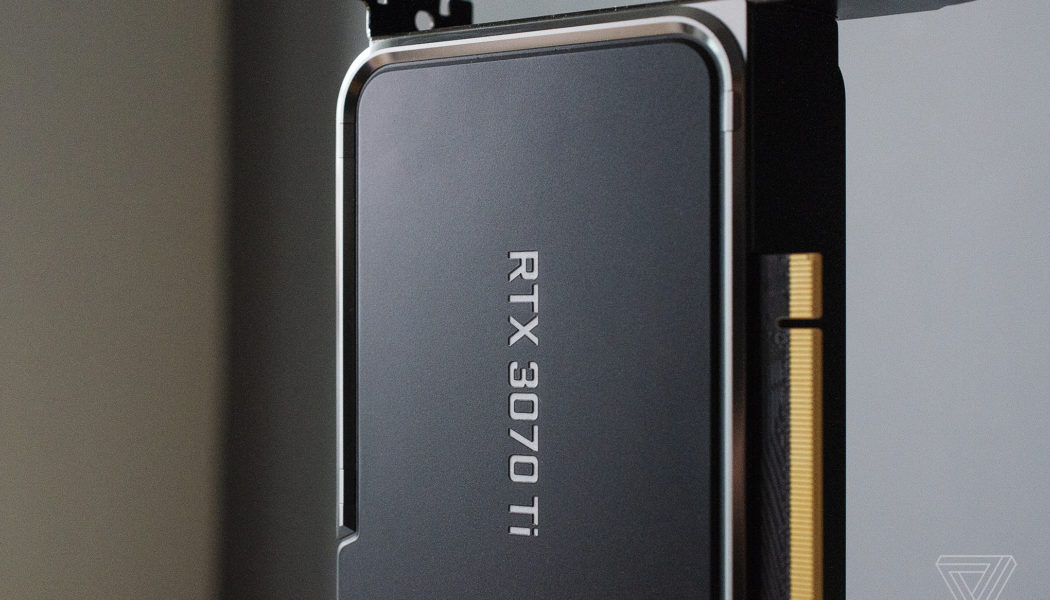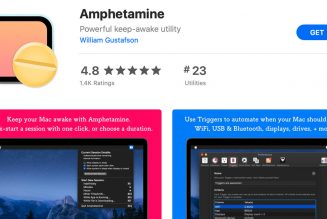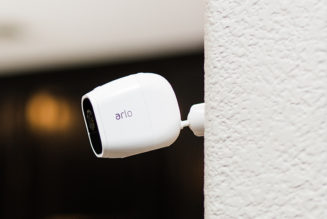When I reviewed Nvidia’s RTX 3070 last year, I called it the sweet spot for 1440p gaming. At $499, it arrived as a more budget-friendly option for those not ready to move to 4K. Now, Nvidia has another option: the $599 RTX 3070 Ti.
Compared to the standard version, the RTX 3070 Ti has been redesigned and comes with 8GB of newer and more efficient GDDR6X RAM instead of GDDR6. Like all of Nvidia’s 30-series cards, the RTX 3070 Ti also supports ray tracing and AI-powered DLSS technology to improve frame rates and maintain image quality.
The bump to performance is small, though. I spent the last week testing out the RTX 3070 Ti at both 1440p and 4K, and in most titles, it falls behind AMD’s cheaper RX 6800 card. I wasn’t expecting the RTX 3070 Ti to come close to the RTX 3080, but there’s a big enough performance gap here where it makes more sense to buy AMD’s RX 6800 or be willing to pay extra for the RTX 3080.
None of this pricing really matters, though. We’re in the middle of a global chip shortage that’s driving GPU prices to ridiculous levels way beyond $1,000 a card. You’ll probably end up buying whatever GPU is available to buy at your ideal price point.
Hardware
Nvidia has turned the RTX 3070 Ti into what looks like a smaller version of the RTX 3080. It’s a design bump over the RTX 3070, which results in the 3070 Ti being slightly longer and requiring more power. The RTX 3070 Ti has one fan on either side of the card, with a push-pull system in place. The bottom fan pulls cool air into the card, which then exhausts on the opposite side that’s closest to your CPU cooler and rear case fan. A traditional blower cooler also exhausts the hot air out of the PCIe slot at the back.
It’s the same system found on the RTX 3080, and it keeps the RTX 3070 Ti humming along quietly. Just like the RTX 3070 before it, Nvidia is using its new 12-pin single power connector. It’s designed to replace existing 6- or 8-pin connectors, and there’s an adapter in the box. Due to the new power requirements, you’ll need to use two single 8-pin connectors with the adapter. I’d highly recommend just getting a single new cable (they’re around $20) from your PSU supplier to connect directly to this card, as it’s way less clunky than the included adapter.
:no_upscale()/cdn.vox-cdn.com/uploads/chorus_asset/file/22645494/twarren_20210607_4625_0007.jpg)
The RTX 3070 Ti has all the ports you’d expect to find on a modern GPU. There’s a single HDMI 2.1 port and three DisplayPort 1.4a ports. While the RTX 3070 design was simple, I much prefer the look of the 3070 Ti. It doesn’t have light-up LEDs like the RTX 3080, but it still looks great inside a case with a window.
Unfortunately, the RTX 3070 Ti requires more power than the RTX 3070. The RTX 3070 Ti pulls up to 290 watts by itself, a more than 30 percent jump over the RTX 3070. This also means Nvidia is recommending a 750W power supply here, instead of the 650W requirement for the RTX 3070. That pushes the 3070 Ti up to the same power supply requirements as the RTX 3090, even though it consumes far less power. It’s a big jump considering the RTX 2070 only needed a 550W power supply.
:no_upscale()/cdn.vox-cdn.com/uploads/chorus_asset/file/22645496/twarren_20210607_4625_0010.jpg)
1440p testing
I’ve been testing the RTX 3070 Ti with Intel’s latest Core i9 processor. For 1440p tests, I’ve also paired the GPU with a 32-inch Samsung Odyssey G7 monitor. This monitor supports refresh rates up to 240Hz, as well as Nvidia’s G-Sync technology.
I compared the RTX 3070 Ti with the previous RTX 3070, the RTX 3080, and AMD’s RX 6800 to figure out where it fits into the $599 price point. I tested a variety of AAA titles, including Fortnite, Control, Death Stranding, Metro Exodus, Call of Duty: Warzone, Microsoft Flight Simulator, and many more. You can also find the same games tested at 4K resolution below.
All games were tested at max or ultra settings on the RTX 3070 Ti, and nearly all of them comfortably exceeded 60fps, with some reaching 100fps and beyond. Gears 5, Control, and Assassin’s Creed Valhalla saw the biggest gains over the RTX 3070 here, with more than 10 percent improvement each. But Call of Duty: Warzone, Death Stranding, Microsoft Flight Simulator, and Watch Dogs: Legion were the same or very close.
RTX 3070 Ti (1440p)
| Benchmark | RTX 3070 Founders Edition | RTX 3070 Ti Founders Edition | AMD RX 6800 | RTX 3080 Founders Edition |
|---|---|---|---|---|
| Benchmark | RTX 3070 Founders Edition | RTX 3070 Ti Founders Edition | AMD RX 6800 | RTX 3080 Founders Edition |
| Microsoft Flight Simulator | 40fps | 39fps | 41fps | 46fps |
| Shadow of the Tomb Raider | 115fps | 126fps | 136fps | 147fps |
| Shadow of the Tomb Raider (DLSS) | 119fps | 128fps | N/A | 154fps |
| CoD: Warzone | 119fps | 119fps | 134fps | 124fps |
| CoD: Warzone (DLSS+RT) | 127fps | 125fps | 134fps (only RT) | 133fps |
| Fortnite | 132fps | 142fps | 157fps | 160fps |
| Fortnite (DLSS) | 153fps | 164fps | N/A | 181fps |
| Gears 5 | 72fps | 84fps | 103fps | 87fps |
| Death Stranding | 136fps | 136fps | 155fps | 163fps |
| Death Stranding (DLSS quality) | 165fps | 153fps | N/A | 197fps |
| Control | 95fps | 107fps | 101fps | 124fps |
| Control (DLSS quality + RT) | 98fps | 109fps | 51fps (only RT) | 126fps |
| Metro Exodus | 43fps | 46fps | 45fps | 56fps |
| Metro Exodus (DLSS+RT) | 53fps | 56fps | 39fps | 67fps |
| Assassin’s Creed: Valhalla | 64fps | 72fps | 96fps | 73fps |
| Watch Dogs: Legion | 65fps | 67fps | 71fps | 79fps |
| Watch Dogs: Legion (DLSS+RT) | 43fps | 44fps | N/A | 67fps |
| Watch Dogs: Legion (RT) | 24fps | 33fps | 28fps | 49fps |
Fortnite and Death Stranding were the best performing games at 1440p, and with DLSS enabled, both exceeded 150fps averages. The RTX 3070 Ti is extremely capable at 1440p, and if you’re willing to lower settings in favor of high frame rates, then this card will pair very well with 144Hz or faster monitors.
Where the RTX 3070 Ti really disappoints is when you compare it to the AMD competition. AMD’s RX 6800 beats the RTX 3070 Ti in nearly every game at 1440p, with Control and Metro Exodus being the rare exceptions. Some of AMD’s beats here are significant, with Gears 5 and Assassin’s Creed Valhalla both seeing more than 20 percent performance increases. I tested all cards with Nvidia’s Resizable Bar enabled and AMD’s Smart Access Memory enabled. Both are identical technologies designed to boost frame rates, and it’s clear certain games favor AMD’s card here.
:no_upscale()/cdn.vox-cdn.com/uploads/chorus_asset/file/22645495/twarren_20210607_4625_0009.jpg)
4K testing
Over on the 4K side, performance is less impressive. I used Acer’s 27-inch Nitro XV273K, a 4K monitor that offers up to 144Hz refresh rates and G-Sync support for all of the testing. None of the games came close to maxing out the 144Hz refresh rate, and if you really want high frame rate 4K gaming, then you’ll need an RTX 3080 or RTX 3080 Ti.
Only half of the games I tested managed to hit 60fps or beyond at 4K, and you’ll need to drop settings to high or mid levels to achieve playable frame rates. Like always, DLSS helps, but ray tracing alone is too much for this card at 4K. Watch Dogs: Legion ran at just 10fps and was unplayable at ultra settings and with ray tracing on. DLSS helped bump that to a slightly more playable 26fps, but that’s still not a very smooth experience.
RTX 3070 Ti (4K)
| Benchmark | RTX 3070 Founders Edition | RTX 3070 Ti Founders Edition | AMD RX 6800 | RTX 3080 Founders Edition |
|---|---|---|---|---|
| Benchmark | RTX 3070 Founders Edition | RTX 3070 Ti Founders Edition | AMD RX 6800 | RTX 3080 Founders Edition |
| Microsoft Flight Simulator | 21fps | 21fps | 26fps | 30fps |
| Shadow of the Tomb Raider | 62fps | 69fps | 71fps | 84fps |
| Shadow of the Tomb Raider (DLSS) | 75fps | 82fps | N/A | 102fps |
| CoD: Warzone | 67fps | 67fps | 84fps | 89fps |
| CoD: Warzone (DLSS+RT) | 68fps | 95fps | 82fps (only RT) | 119fps |
| Fortnite | 67fps | 71fps | 76fps | 84fps |
| Fortnite (DLSS) | 101fps | 108fps | N/A | 124fps |
| Gears 5 | 45fps | 51fps | 56fps | 64fps |
| Death Stranding | 78fps | 85fps | 90fps | 98fps |
| Death Stranding (DLSS quality) | 103fps | 114fps | N/A | 131fps |
| Control | 55fps | 55fps | 51fps | 65fps |
| Control (DLSS quality + RT) | 54fps | 62fps | 24fps (only RT) | 72fps |
| Metro Exodus | 25fps | 28fps | 26fps | 34fps |
| Metro Exodus (DLSS+RT) | 38fps | 41fps | 22fps | 50fps |
| Assassin’s Creed: Valhalla | 55fps | 63fps | 89fps | 64fps |
| Watch Dogs: Legion | 38fps | 39fps | 43fps | 52fps |
| Watch Dogs: Legion (DLSS+RT) | 27fps | 26fps | N/A | 40fps |
| Watch Dogs: Legion (RT) | 7fps | 10fps | 15fps | 21fps |
Much like at 1440p, AMD also beats Nvidia here with the RX 6800. Microsoft Flight Simulator, Assassin’s Creed Valhalla, and Call of Duty: Warzone all manage more than 20 percent improvements over the RTX 3070 Ti. Where the RTX 3070 Ti really excels against AMD is when you enable DLSS, but with AMD’s answer to DLSS arriving later this month, that could soon change.
Some of the gaps in performance between the RTX 3070 Ti and RX 6800 are likely down to AMD’s Smart Access Memory performing well in certain titles, compared to Nvidia’s more limited Resizable BAR support. I also noticed during Watch Dogs: Legion tests that the average frame rate varied heavily during tests, in what could be some type of driver or game bug. Nvidia is currently investigating whether this is a bug or not.
:no_upscale()/cdn.vox-cdn.com/uploads/chorus_asset/file/22645492/twarren_20210607_4625_0005.jpg)
With a $599 retail price, I was expecting more from the RTX 3070 Ti. AMD’s RX 6800 is still technically priced lower than the RTX 3070 Ti, and my tests showed it surprisingly outperformed the Nvidia card. On the Nvidia side, you get the addition of DLSS and with that better ray-tracing performance if you couple them together. Nvidia’s NVENC and professional tooling support is also extremely useful if you’re video editing or streaming to Twitch.
But for games, AMD’s RX 6800 takes the edge at this price point. Nvidia’s RTX 3070 Ti also only ships with 8GB of VRAM, compared to the 16GB found on the RX 6800. I can’t help but feel like 8GB will be challenging at some point during the lifetime of this card, so it’s a shame Nvidia only bumped the memory spec and not the size.
Not that the retail pricing of either card really matters right now. The chances are very slim that you’ll be able to find the RX 6800 or RTX 3070 Ti in stock this week. That means, once again, the best GPU you can buy right now is often whatever you can actually buy.
Photography by Tom Warren / The Verge










